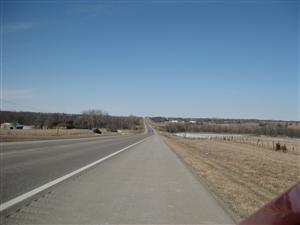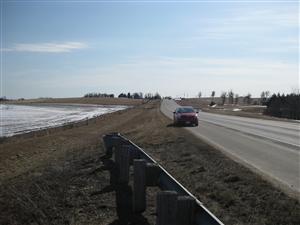The Battle of the Spurs
Tour Stop
Directions: A historical marker [ Waypoint = N39 33.961 W95 43.994 ] for The Battle of the Spurs is located on the roadside along US Highway 75, about 7 miles north of Holton, Kansas 66416 in Jackson County.
- From The Lane Trail Historical Marker, back track to US Highway 75 and head south.
- After about 19.2 miles, turn left (east) onto 286 Road.
- The marker is located just east of the highway. About 0.75 miles north of the marker, US Highway 75 crosses Spring Creek near where the “battle” took place.
Description: The marker's text reads as follows:
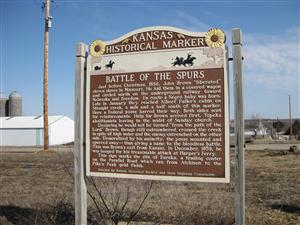
“Just before Christmas 1858, John Brown "liberated" eleven slaves in Missouri. He hid them in a covered wagon and circled north on the underground railway toward Nebraska and freedom. En route a Negro baby was born. Late in January they reached Albert Fuller's cabin on Straight creek a mile and a half south of this marker. Here a Federal posse barred their way. Both sides sent for reinforcements. Help for Brown arrived first, Topeka abolitionists leaving in the midst of Sunday church.
Declaring he would not be turned "from the path of the Lord," Brown, though still outnumbered, crossed the creek in spite of high water and the enemy entrenched on the other side. Demoralized by his audacity, the posse mounted and spurred away–thus giving a name to the bloodless battle. This was Brown's exit from Kansas. In December, 1859, he was hanged for his treasonable attack at Harper's Ferry.
This sign marks the site of Eureka, a trading center on the Parallel Road which ran from Atchison to the Pike's Peak gold fields.
Erected by Kansas Historical Society and State Highway Commission”
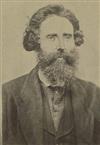 In June of 1858, John Brown's plans to foment a slave revolution in the south had been put temporarily on hold. Brown had had a falling out with Hugh Forbes, a mercenary Brown had hired to help him plan and execute his slave revolt. Now Forbes was telling others about Brown's plans and Brown's financial backers were afraid of being exposed. Brown decided to return to Kansas until events had calmed down back east. He would bide his time working to free slaves using the Underground Railroad. But John Brown was a wanted man in the Kansas Territory. Rewards for the arrest of John Brown had been issued by the Federal Government ($250) and by the State of Missouri ($3,000). The territorial governor of Kansas had put out a reward of $500 for Brown's arrest following a raid on Paris, Kansas by James Montgomery. Then Montgomery led a raid against Fort Scott, Kansas to free a Free Stater that was imprisoned there. Although John Brown was eager to participate in this raid, Montgomery would not let Brown participate in the action.
In June of 1858, John Brown's plans to foment a slave revolution in the south had been put temporarily on hold. Brown had had a falling out with Hugh Forbes, a mercenary Brown had hired to help him plan and execute his slave revolt. Now Forbes was telling others about Brown's plans and Brown's financial backers were afraid of being exposed. Brown decided to return to Kansas until events had calmed down back east. He would bide his time working to free slaves using the Underground Railroad. But John Brown was a wanted man in the Kansas Territory. Rewards for the arrest of John Brown had been issued by the Federal Government ($250) and by the State of Missouri ($3,000). The territorial governor of Kansas had put out a reward of $500 for Brown's arrest following a raid on Paris, Kansas by James Montgomery. Then Montgomery led a raid against Fort Scott, Kansas to free a Free Stater that was imprisoned there. Although John Brown was eager to participate in this raid, Montgomery would not let Brown participate in the action.
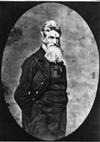 But John Brown was a man of action. In December of 1858, John Brown would lead a band of twenty men in a raid across the border into Vernon County, Missouri. On December 20th, Brown split his men into two groups, one led by him and one led by Aaron Stevens, Brown's second in command. Their objective was to free slaves. Brown would free 10 slaves and confiscate property including horses, mules and wagons. The Stevens-led group ended up freeing one slave and confiscating the slave owner's property. During the action, Stevens would shoot and kill a slave owner named David Cruise. Brown and Stevens joined back up on the morning of December 21st and took the 11, now fugitive, slaves back across the border into Kansas. They would begin a slow 2 ½ month journey of over 1,100 miles to their freedom.
But John Brown was a man of action. In December of 1858, John Brown would lead a band of twenty men in a raid across the border into Vernon County, Missouri. On December 20th, Brown split his men into two groups, one led by him and one led by Aaron Stevens, Brown's second in command. Their objective was to free slaves. Brown would free 10 slaves and confiscate property including horses, mules and wagons. The Stevens-led group ended up freeing one slave and confiscating the slave owner's property. During the action, Stevens would shoot and kill a slave owner named David Cruise. Brown and Stevens joined back up on the morning of December 21st and took the 11, now fugitive, slaves back across the border into Kansas. They would begin a slow 2 ½ month journey of over 1,100 miles to their freedom.
John Brown would take refuge at the home of his old friend, Augustus Wattles, who lived in the town of Moneka, Kansas (near present day Mound City, Kansas). It was here where John Brown wrote his famous “Parallels” draft, comparing his liberating eleven slaves to the shooting of eleven free-state men at the Marais Des Cygnes Massacre. Brown's raid into Missouri was certainly stirring up trouble along the border. It threatened the uneasy truce that had been in effect for the past year. His supporters in Kansas were becoming few and far between.
John Brown's "Parallels"
Designated "Old Brown's Parallels" and dated January 13, 1859, from Trading Post, Kansas, this is one of the better-known John Brown documents from Kansas. Brown actually wrote this document at the home of Augustus Wattles near Mound City, Kansas but postmarked it Trading Post for the irony and to confuse his enemies. John Brown drafted this letter for publication in the newspapers just before his final departure from the Kansas Territory, The original document is located at the Kansas State Historical Society.
Lawrence Republican, January 13, 1859
Trading Post, Kansas, Jan., 1859
Gents:--You will greatly oblige a humble friend, by allowing the use of your columns, while I briefly state two parallels, in my poor way.
Not one year ago, eleven quiet citizens of this neighborhood, viz.: Wm. Robertson, Wm. Colpetzer, Amos Hall, Austin Hall, John Campbell, Asa Snyder, Thos. Stilwell, Wm. Hairgrove, Asa Hairgrove, Patrick Ross, and B.L. Reed, were gathered up from their work and their homes, by an armed forced (sic) under one Hamilton, and without trial or opportunity to speak in their own defence, were formed into a line, and all but one shot--five killed and five wounded. One fell unharmed, pretending to be dead. All were left for dead. The only crime charged against them was that of being Free-State men. Now, I inquire, what action has ever, since the occurrence in May last, been taken by either the President of the United States, the Governor of Missouri, the Governor of Kansas, or any of their tools, or by any pro-slavery or Administration man, to ferret out and punish the perpetrators of this crime?
Now for the other parallel. On Sunday, the 19th of December, a Negro man called Jim, came over to the Osage settlement, from Missouri, and stated that he, together with his wife, two children, and another Negro man were to be sold within a day or two, and begged for help to get away. On Monday (the following) night, two small companies were made up to go to Missouri and forcibly liberate the five slaves, together with other slaves. One of these companies I assumed to direct. We proceeded to the place, surrounded the buildings, liberated the slaves, and also took certain property supposed to belong to the estate.
We however learned, before leaving, that a portion of the articles we had taken belonged to a man living on the plantation as a tenant, and who was supposed to have no interest in the estate. We promptly returned to him all we had taken. We then went to another plantation, where we freed five more slaves, took some property, and two white men. We moved all slowly away into the Territory for some distance, and then sent the white men back, telling them to follow us as soon as they chose to do so. The other company freed one female slave, took some property, and, as I am informed, killed one white man (the master) who fought against the liberation.
Now for a comparison. Eleven persons are forcibly restored to their natural and inalienable rights, with but one man killed, and all "hell is stirred, from beneath." It is currently reported that the Governor of Missouri has made a requisition upon the Governor of Kansas for the delivery of all such as were concerned in the last named "dreadful outrage." The Marshal of Kansas is said to be collecting a posse of Missouri (not Kansas) men, at West Point, in Missouri, a little town about ten miles distant, to "enforce the laws." All pro-slavery, conservative Free-State and doughface men , and Administration tools, are filled with holy horror.
Consider the two cases, and the action of the Administration party.
Respectfully Yours,
John Brown
 The path Brown used followed The Lane Trail that Jame H. Lane had established in 1856 to enable free-state immigrants to avoid the roadblocks established by pro-slavery Missourians. Early in the morning of January 28th, they had to stop for awhile at Fuller's Station on Straight Creek north of Holton, Kansas. Here was where Aaron Stevens encountered a group of eight federal troops that were on the lookout for John Brown and the fugitive slaves. Stevens led the federals back to Fuller's Cabin. Once in the cabin, Stevens grabbed a Sharps rifle and turned it on the federals. One of the federals was captured while the other seven quickly rode away.
The path Brown used followed The Lane Trail that Jame H. Lane had established in 1856 to enable free-state immigrants to avoid the roadblocks established by pro-slavery Missourians. Early in the morning of January 28th, they had to stop for awhile at Fuller's Station on Straight Creek north of Holton, Kansas. Here was where Aaron Stevens encountered a group of eight federal troops that were on the lookout for John Brown and the fugitive slaves. Stevens led the federals back to Fuller's Cabin. Once in the cabin, Stevens grabbed a Sharps rifle and turned it on the federals. One of the federals was captured while the other seven quickly rode away.
Now Brown sent word back to Topeka for them to send him some reinforcements to help against the federals. The federals were part of a posse led by Deputy Marshall John P. Wood, who was operating out of Lecompton, Kansas. Now that Wood knew Brown was in the vicinity, he sent word back to Atchinson, Kansas for reinforcements of his own. By January 31st, John Brown's force had grown to 21 men and Wood's posse had grown to 45 men.
John Brown moved the fugitives up to Smith's Station on Spring Creek in the early morning of January 31, 1859. Wood's posse established their position on the north side of Spring Creek [ Waypoint = N39 34.564 W95 43.925 ]. Throwing caution to the wind, Brown ordered his men to cross the creek as rapidly as possible and charge the federals. Probably due to John Brown's reputation for fearlessness and violence, the federals withdrew as quickly as possible. There were no shots fired during this engagement. A reporter later called this The Battle of the Spurs, because the federals had used their horses to run away from the scene.
William F. Creitz, a resident of Holton who had served under Aaron Stevens, later described “the particulars of 'Old John Brown's' final departure from this territory”:
“The enemy's scouts kept hovering around Brown's position day and night, but were careful never to come within Sharps rifle range. At 10, o'clock A.M. of the 31 st of Jan the Topeka Company arrived in Brown's Camp: immediately preparations were made to commence the march. At 2 O'clock P.M. Straight Creek was safely crossed. and the entire party, fugitives included, numbering twenty- five men, were ordered to march directly for the headquarters of the ruffians, at Eureka.
As soon as the enemy became aware of Brown's approach. they beat to arms, and drew up their men in battle array, on an elevated position, in the rear of Eureka: their Scouting parties were called in, and the movements of both parties for some time indicated, that a general engagement was about to take place.
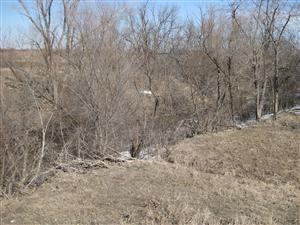
John Brown would continue leading the fugitive slaves over 1,100 miles during the winter to freedom in Canada. He soon left Kansas, never to return.
Back: The Lane Trail
Next: Jim Lane's Fort

